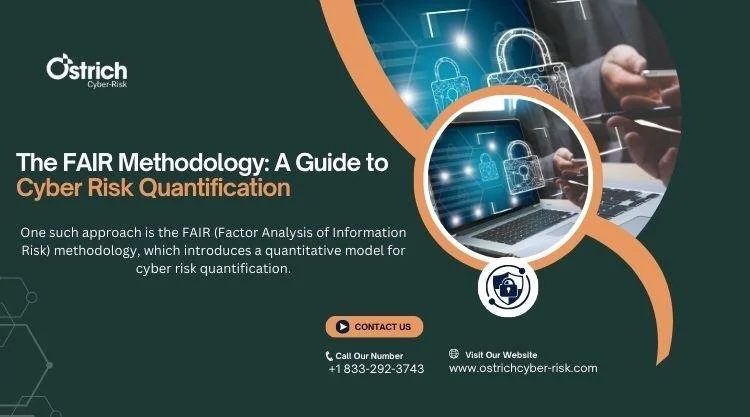The FAIR Methodology: A Guide to Cyber Risk Quantification
In today's ever-evolving digital landscape, organizations are constantly confronted with a variety of cyber risks that can significantly affect their operations. Traditional methods of cybersecurity - like relying solely on compliance-based frameworks - simply don't cut it anymore when it comes to protecting businesses from these growing threats. To tackle cyber risks head-on, many organizations are shifting toward risk-based approaches that offer a more precise understanding of the potential financial impact these risks could have.
One such approach is the FAIR (Factor Analysis of Information Risk) methodology, which introduces a quantitative model for cyber risk quantification. In this detailed guide, we'll dive into the FAIR methodology, its advantages, limitations, and how it's revolutionizing the way businesses manage cyber risk.
Understanding the Need for a New Cyber Risk Analysis Methodology
For over 30 years, risk analysis methods in the cybersecurity space have predominantly leaned on qualitative assessments. These approaches - such as well-known frameworks like the NIST Cybersecurity Framework and ISO 27005 - have been based on expert judgment and typically provide qualitative risk rankings. While these frameworks serve as a foundation for best practices and promote good cyber security program management, they don't provide an objective, standardized way of measuring risk. This lack of quantifiable data makes it tough for organizations to truly understand their exposure and prioritize resources effectively across different business functions.
The FAIR methodology was developed precisely to address these gaps. By translating cyber risk into financial terms, FAIR provides businesses with a way to better grasp the potential financial impact of various cyber risks. This lets organizations compare different risk scenarios, allocate resources more effectively, and make well-informed decisions about their cybersecurity strategy. It also establishes a common framework that enables everyone in the organization - whether cybersecurity experts, business managers, or upper management - to be on the same page about the level of risk.
The Framework and Objectives of the FAIR Standard
At its core, the FAIR methodology offers a structured approach to conducting cyber risk assessments across all business functions. The framework includes a taxonomy that clarifies key risk factors like threats, assets, vulnerabilities, controls, and audits. This clarity helps organizations better understand their cyber risk exposure.
One of the most significant features of the FAIR approach is its "frequency x magnitude" model. This model takes a closer look at cyber risk by breaking it down into measurable elements and using statistical data to quantify the potential financial impact. The primary objective is to assess complex risk scenarios, identify key data points for quantification, and understand how these factors interact with each other. The result? A financially quantified picture of risk, which enables smarter, data-driven decisions for your cyber security program management.
Key Components of the FAIR Methodology
The FAIR methodology breaks down risk into specific components that allow for a detailed and objective risk assessment. Here's a look at these key components:
1. Loss Event Frequency (LEF)
This measures the likelihood of a loss event occurring within a given timeframe. It factors in threat event frequency (how often a threat could occur) and vulnerabilities (how likely those threats are to turn into actual loss events).
2. Loss Magnitude (LM)
Loss Magnitude evaluates the potential financial impact of a loss event. This includes both primary losses (direct financial impact on stakeholders) and secondary losses (indirect losses, like damage to reputation).
3. Asset Value
The value of an asset is crucial in determining the severity of a loss. FAIR takes into account various factors like the asset's criticality, its cost, its sensitivity, and its role in the organization's competitive advantage. By assessing the value of these assets, businesses can prioritize their proactive risk management efforts.
4. Threat Factors
Threat factors focus on the potential actions of cyber adversaries, including the impact they might have on the confidentiality, integrity, and availability of your assets. Understanding these threats allows organizations to implement the most effective controls and countermeasures.
5. Risk Factors
Risk factors look at how assets, threats, and the organization's overall environment intersect. These include things like contact frequency (how often assets interact with threats), probability of action (how likely an attack will succeed), and the strength of defenses in place.
Benefits and Limitations of the FAIR Methodology
Adopting the FAIR methodology can offer your organization a multitude of benefits, especially when it comes to managing cyber risk assessments and improving your overall cyber risk posture. Here's a look at some key advantages:
Benefits:
1. Objective Risk Measurement
FAIR provides a quantifiable and financially grounded perspective on cyber risk. This makes it easier for organizations to compare risk scenarios, prioritize actions, and focus on areas that will make the most significant impact.
2. Improved Decision-Making
Thanks to its financial framework, the FAIR methodology empowers businesses to make well-informed decisions about cybersecurity program management. Whether it's investing in technology, securing insurance, or implementing risk reduction strategies, FAIR helps you allocate resources efficiently and effectively.
3. Common Language Across the Organization
By providing a standardized risk framework, FAIR helps everyone - cybersecurity experts, business leaders, and IT teams - speak the same language when it comes to assessing and managing risk. This fosters collaboration and ensures that the entire organization is aligned in its proactive risk management efforts.
Limitations:
4. Subjectivity in Data Collection
The effectiveness of the FAIR methodology relies heavily on the accuracy and reliability of the data used in risk assessments. Poor data collection practices can lead to inaccurate results, so organizations must ensure they're gathering the right data to support their risk analyses.
5. Resource Intensity
While the FAIR methodology is a powerful tool, implementing it requires significant time, effort, and resources. Businesses need to commit to training their teams, gathering data, and investing in the proper software tools to make the most of the methodology.
6. Probabilistic Nature of the Model
Being a probabilistic model, FAIR doesn't offer exact predictions but instead works with statistics and likelihoods. As a result, the results come with some inherent uncertainty, which means organizations need to apply these findings with some caution.
The Future of Cyber Risk Quantification with FAIR
As cyber threats grow more sophisticated, the demand for a more precise and quantifiable approach to managing risk continues to rise. FAIR has established itself as a leading framework in this space, helping organizations around the world quantify their cyber risks in a way that drives smarter, more effective decision-making.
Looking ahead, FAIR is likely to evolve further to address new challenges in the cyber risk landscape. To make the most of this powerful methodology, organizations can turn to training and certification programs offered by leading institutions, ensuring their teams are equipped to manage cyber security program management with precision.
Final Thoughts
The FAIR methodology offers a game-changing approach to cyber risk quantification, providing organizations with the tools they need to make data-driven decisions and effectively manage risks in today's complex digital world. While it does come with some limitations, its benefits far outweigh the challenges, helping businesses identify, quantify, and prioritize risks based on financial impact rather than gut feeling or guesswork.
At Ostrich Cyber-Risk, we specialize in helping organizations navigate the world of cyber risk management. Our software solutions, built on the FAIR methodology, help businesses achieve comprehensive cyber risk assessments and develop targeted mitigation strategies. Interested in learning more about how we can help safeguard your organization from cyber threats? Visit ostrichcyberrisk.com to discover how we can support your cybersecurity journey.


